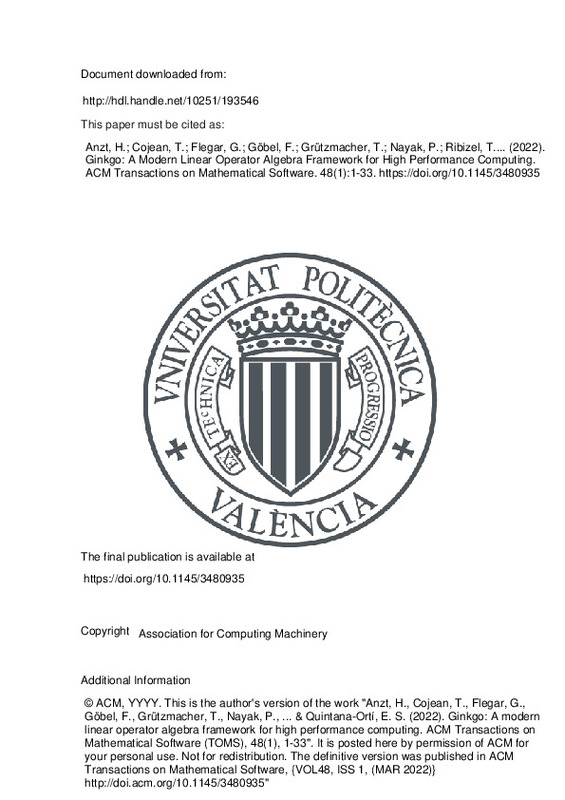Anzt, H.; Cojean, T.; Flegar, G.; Göbel, F.; Grützmacher, T.; Nayak, P.; Ribizel, T.... (2022). Ginkgo: A Modern Linear Operator Algebra Framework for High Performance Computing. ACM Transactions on Mathematical Software. 48(1):1-33. https://doi.org/10.1145/3480935
Por favor, use este identificador para citar o enlazar este ítem: http://hdl.handle.net/10251/193546
|
Título:
|
Ginkgo: A Modern Linear Operator Algebra Framework for High Performance Computing
|
|
Autor:
|
Anzt, Hartwig
Cojean, Terry
Flegar, Goran
Göbel, Fritz
Grützmacher, Thomas
Nayak, Pratik
Ribizel, Tobias
Tsai, Yuhsiang Mike

 Quintana-Ortí, Enrique S.
Quintana-Ortí, Enrique S.
|
|
Entidad UPV:
|
Universitat Politècnica de València. Escola Tècnica Superior d'Enginyeria Informàtica
|
|
Fecha difusión:
|
|
|
Resumen:
|
[EN] In this article, we present GINKGO, a modern C++ math library for scientific high performance computing. While classical linear algebra libraries act on matrix and vector objects, Gnswo's design principle abstracts ...[+]
[EN] In this article, we present GINKGO, a modern C++ math library for scientific high performance computing. While classical linear algebra libraries act on matrix and vector objects, Gnswo's design principle abstracts all functionality as linear operators," motivating the notation of a "linear operator algebra library" GINKGO'S current focus is oriented toward providing sparse linear algebra functionality for high performance graphics processing unit (GPU) architectures, but given the library design, this focus can be easily extended to accommodate other algorithms and hardware architectures. We introduce this sophisticated software architecture that separates core algorithms from architecture-specific backends and provide details on extensibility and sustainability measures. We also demonstrate GINKGO'S usability by providing examples on how to use its functionality inside the MFEM and deal.ii finite element ecosystems. Finally, we offer a practical demonstration of GINKGO'S high performance on state-of-the-art GPU architectures.
[-]
|
|
Palabras clave:
|
High performance computing
,
Healthy software lifecycle
,
Multi-core and manycore architectures
|
|
Derechos de uso:
|
Reserva de todos los derechos
|
|
Fuente:
|
ACM Transactions on Mathematical Software. (issn:
0098-3500
)
|
|
DOI:
|
10.1145/3480935
|
|
Editorial:
|
Association for Computing Machinery
|
|
Versión del editor:
|
https://doi.org/10.1145/3480935
|
|
Código del Proyecto:
|
info:eu-repo/grantAgreement/AEI/Plan Estatal de Investigación Científica y Técnica y de Innovación 2013-2016/TIN2017-82972-R/ES/TECNICAS ALGORITMICAS PARA COMPUTACION DE ALTO RENDIMIENTO CONSCIENTE DEL CONSUMO ENERGETICO Y RESISTENTE A ERRORES/
info:eu-repo/grantAgreement/DOE//17-SC-20-SC//Exascale Computing Project/
info:eu-repo/grantAgreement/EC/H2020/732631/EU
info:eu-repo/grantAgreement/Helmholtz Association of German Research Centers//VH-NG-1241/
|
|
Descripción:
|
© ACM, YYYY. This is the author's version of the work "Anzt, H., Cojean, T., Flegar, G., Göbel, F., Grützmacher, T., Nayak, P., ... & Quintana-Ortí, E. S. (2022). Ginkgo: A modern linear operator algebra framework for high performance computing. ACM Transactions on Mathematical Software (TOMS), 48(1), 1-33". It is posted here by permission of ACM for your personal use. Not for redistribution. The definitive version was published in ACM Transactions on Mathematical Software, {VOL48, ISS 1, (MAR 2022)} http://doi.acm.org/10.1145/3480935"
|
|
Agradecimientos:
|
This work was supported by the "Impuls und Vernetzungsfond of the Helmholtz Association" under grant VH-NG-1241. G. Flegar and E. S. Quintana-Orti were supported by project TIN2017-82972-R of the MINECO and FEDER and the ...[+]
This work was supported by the "Impuls und Vernetzungsfond of the Helmholtz Association" under grant VH-NG-1241. G. Flegar and E. S. Quintana-Orti were supported by project TIN2017-82972-R of the MINECO and FEDER and the H2020 EU FETHPC Project 732631 "OPRECOMP". This researchwas also supported by the Exascale Computing Project (17-SC-20-SC), a collaborative effort of the U.S. Department of Energy Office of Science and the National Nuclear Security Administration. The experiments on the NVIDIA A100 GPU were performed on the HAICORE@KIT partition, funded by the "Impuls und Vernetzungsfond" of the Helmholtz Association. The experiments on the AMD MI100 GPU were performed on Tulip, an early-access platform hosted by HPE.
[-]
|
|
Tipo:
|
Artículo
|







![[Cerrado]](/themes/UPV/images/candado.png)


